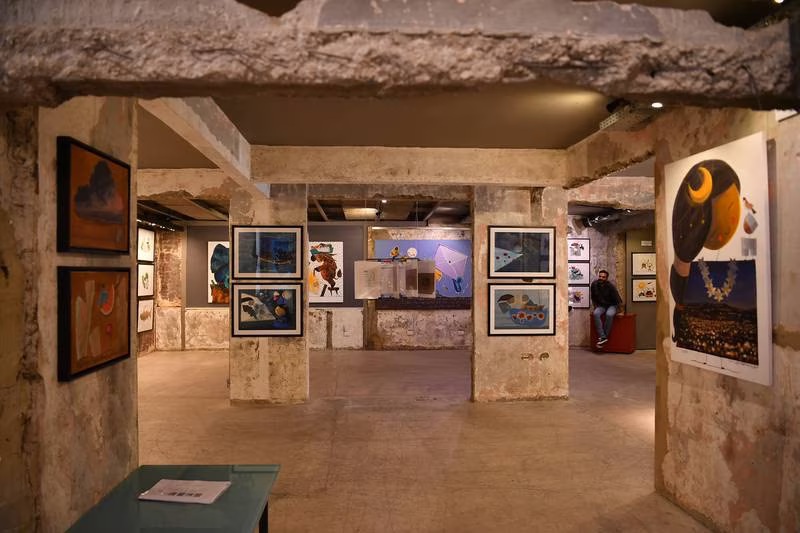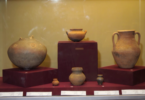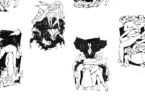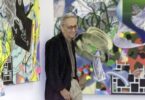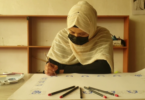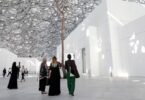Maghie Ghali
Syrian artist Majd Kurdieh’s distinctive style has changed subtly over the past decade, but what remains at the core of his work is storytelling and emotion, highlighted by the childlike characters he uses across all his works.
His recently opened retrospective exhibition, presented by Fann A Porter in collaboration with Lebanese art platform Zaat, in Hamra, Beirut, puts this into sharp focus. Running until June 26, the exhibition showcases about 100 artworks created between 2014 and this year, displaying several series from different stages of his artistic career.
“What defines my work is the characters. For example, there is Fasoon and Fasoonah, who are very important, poetic characters, for they are the Knights of The Watermelon,” Kurdieh tells The National. “The Donkey is the King of The Watermelon and he has the Watermelon Crown. There’s the elephant with a fish for a heart. He always struggled with his heart and there’s so many conversations between the two – one is big and strong, the other small and fragile.
:quality(70)/cloudfront-eu-central-1.images.arcpublishing.com/thenational/NV3OBWUQUNBSLI4AGTSIWX6S5E.JPG)
:quality(70)/cloudfront-eu-central-1.images.arcpublishing.com/thenational/3XVOUFCIA5DAFG3E5TQQFFUDHM.jpg)
:quality(70)/cloudfront-eu-central-1.images.arcpublishing.com/thenational/X546K2TUHZDCTJ7SNGZWQ6NM2Q.JPG)
:quality(70)/cloudfront-eu-central-1.images.arcpublishing.com/thenational/ZET5PQ4EJJED3PSJN4OBQ6Z3JU.jpg)
:quality(70)/cloudfront-eu-central-1.images.arcpublishing.com/thenational/NX2UCWNYHVAXTORRJIUK3BE23E.JPG)
:quality(70)/cloudfront-eu-central-1.images.arcpublishing.com/thenational/RO4AIL4BSFDUTK542D3P754524.jpg)
:quality(70)/cloudfront-eu-central-1.images.arcpublishing.com/thenational/DJSXQZO5JNADXFGQMIFC2XBG3Y.jpg)
:quality(70)/cloudfront-eu-central-1.images.arcpublishing.com/thenational/MLJET7WTFFDIRHW4LCJXMVYISI.jpg)
Syrian artist Majd Kurdieh’s retrospective exhibition in Hamra, Beirut, showcases about 100 artworks created between 2014 and 2030. All Photos: Fann A Porter
“There is the Mouse, who believes nothing is impossible. There is sadness who is represented as the Whale, who hides behind the Butterfly and there’s Cactus who can take the shape of a house or a heart,” he explains, naming the cast of many stories. “I use these characters to try to express human feelings – joy, sadness, depression, hope, and the conflict between a person and their inner self.”
Born in Aleppo, Syria in 1985, Kurdieh now lives and works in Aamchit, Lebanon, where he has resided since 2013.
Known for his cartoon style resembling children’s drawings – from scribbled line work to contrasting bright colours – Kurdieh’s visual storytelling tackles issues of war, migration and politics through simple symbolism.
Through a host of characters who traverse the challenges of an imaginary land called The Watermelon, he spins whimsical tales with deeper meanings.
“It’s more digestible and dear to the readers because it takes them back to the nostalgia of their childhoods maybe, and it’s all about emotions they can easily understand,” he says. “It’s not intended to be complicated art or high-level thinking. Anyone can see and understand the drawings and the message, even if they know nothing about art.
“There are some people I met at the exhibitions who said ‘I don’t understand it, but I feel it.’ That’s what’s important for me.”
:quality(70)/cloudfront-eu-central-1.images.arcpublishing.com/thenational/7ZHLZVU7N5C7HKIXMA5CLV7HT4.JPG)
The exhibition begins with The Land Needs Ironing (2014-2016), a series initiated with the onset of the Syrian conflict, using art as a form of catharsis, but also a message of peace. While his works never directly reference real life events, the inspiration is clear in the paintings where the Fasaeen (Tiny Ones) carry on smiling and looking to the future, as war unfolds around them.
His second series, Stealing Sadness (2017-2018), is where he really started to delve into his imaginary world, adding new characters and creating The Very Scary Butterfly Gang – the group of characters who would later show up in his artworks, adding new members to the troupe as new artwork series were created.
“Stealing Sadness is about literally taking the sadness of the people because we cannot give them joy. Joy is felt inside so it can’t be imposed on someone else, but we can still make the world less sad by being kind and peaceful to each other,” Kurdieh explains. “The drawings also show humans as butterflies, as you cannot touch butterflies harshly, because you’ll break their wings.
“It was the first time I introduced the Very Scary Butterfly Gang. Despite their name, they’re not scary at all, but are instead defenders of humanity.” Over the years, Kurdieh’s style has evolved, saying his characters change in the same way that a living person such as himself grows.
His 2018 series Surrender to Love shows this clearly, with Kurdieh no longer using black outlines on his characters, adopting a more realistic style of drawing, to signify the characters softening their hearts and shedding their previous confines.
“I now use less words in my artworks – only three or four words,” he notes. “In my first artworks, it was more like a short story, but over time I think I got better at letting the characters express what I wanted to say.”
:quality(70)/cloudfront-eu-central-1.images.arcpublishing.com/thenational/ZET5PQ4EJJED3PSJN4OBQ6Z3JU.jpg)
The show continues with his 2020 series We Continue to Raise the Flag of The Sun, where the Cactus is introduced. The series notes that in Arabic, “cactus” and “patience” have the same root word, and therefore the new Gang member represents this virtue in the watercolour scenes.
In 2021, he continued to use watercolours, as can be seen in Watermelon Peace, a series of about 20 paintings that looks at the turmoil and corruption that has unsettled the region in the last few years. His paintings, imbued with light, vibrant colours, offer peace and love as the antidote to these troubles.
“Watermelon Peace is about the King of The Watermelon, Donkey, who acts the opposite of the real kings,” he says. “If the Watermelon Knights get hungry they could eat from his crown, an idea that would never happen with real kings.”
His latest series, and the final one in the retrospective, is rather different from his previous works. Titled The Wing of the Dream, the oil-on-canvas paintings depict realistic birds, exploring themes of duality and contradiction, as highlighted in the artist statement, as well as freedom in its less obvious forms.
“I introduced a new character in this series, which is the Sparrow, who is all about the dream of freedom and problems of attaining it, especially in the Middle East,” he says. “When we talk about freedom, we often talk about the prisons or about dictators, but I also wanted to explore freedom of the self, in a more poetic way – we can be dictators to our feelings sometimes.”
Despite leaving Syria to escape the conflicts of home, recent upheaval in Lebanon has not hindered the artist, who sees art as a necessary counterpoint to hardship.
Before his move to Aamchit, Kurdieh’s work as a writer and artist didn’t overlap. It was only during a time of strife that he felt the need to combine both his passions, starting an artistic era that has memorialised his creative practice.
“We got used to the hard things. It’s part of our life and it gives us inspiration. If you see most of the famous painters like Picasso, he was affected by World War Two, which was also full of conflict,” he muses. “I think the artists reflect on these conflicts, because for many it’s to remind people of their humanity in difficult times.”
Courtesy: thenationalnews

